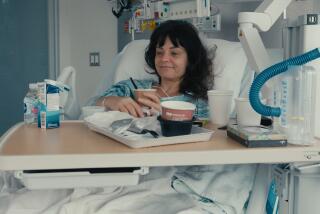Even the Gift of Life Can Be a Gamble
- Share via
Exchanging gifts is a gamble. What we get is not always equal to what we give. Of course we are not supposed to measure gifts any more than we are supposed to count Christmas cards. A gift implies altruism, an offering for which no return is expected. Yet how awkward it is to be caught empty-handed at the exchange. How much more difficult then, to accept a gift for which there can be no quid pro quo, a vital organ--the gift of life.
Only the dead can relinquish a one-of-a-kind heart, lungs or pancreas for transplantation. The “donor” is already gone and the gift is made by the survivors.
But kidneys are different. Though vital, kidneys come in pairs, yet we need only one to function. When kidney transplants became routine in the 1970s, the problem of organ rejection limited transplants to genetically related individuals whose blood and tissue types were very close. There were, even then, kidneys transplanted from cadavers, but they were in short supply and the surgery much less successful than kidneys transplanted from live donors.
Thus when a relative suffered renal failure, the pressure to become a donor could be enormous. The ethics of the request and the repercussions on both donor and recipient disturbed sensitive people in the medical community. In families where there was more than one possible donor, who would choose? What about a possible donor who did not want to endure major surgery? There is, after all, no religious or moral obligation for one person to sacrifice a body part for another.
In 1977, Minnesota researchers Roberta G. Simmons, Susan Klein Marine and Richard L. Simmons published “Gift of Life: The Effect of Organ Transplantation on Individual, Family, and Societal Dynamics.” A decade later Roberta Simmons, a fellow this year at Stanford’s Center for Advanced Studies in the Behavioral Sciences, has revised the book in the light of medical technology and sociological research.
At one time donors were limited to relatives or cadavers, and kidney treatments were not covered by Medicare. Since the development of the drug cyclosporine, improved transfusion procedures and other benefits of medical experience, patients today have a third option. They can accept kidneys from “emotionally related” individuals--friends or spouses--if they prove compatible. Whichever donor they select, or if they opt to continue using dialysis machines, the costs are now covered by Medicare.
In many instances, transplantation is the procedure of choice. In 1985, 7,695 patients received kidney transplants in the United States. After the first year it is cheaper than continued dialysis, and the recipient is freed from the discomfort of the dialysis machine.
The desirability of transplantation together with the technology to use kidneys from unrelated donors raises new ethical dilemmas. Despite the attention now given to transplant procedures, organs are still in short supply, including kidneys. Some transplant centers now accept kidneys from those emotionally related to the patient, such as a spouse. At the same time other centers are reluctant to use kidneys from any live donor, even those genetically related to the patient. In Europe only 9% of transplants are from living donors, as compared to 25% in the United States and 46% at the University of Minnesota. Those at Minnesota point out the advantage to the patient of a living related donor, where the survival rate after three years is 84% as compared to 65% if the kidney comes from a cadaver. The transplant team there believes the advantage to the patient outweighs the risk to the donor. As for the emotionally related donor as opposed to a cadaver, there is the advantage of having time to select a good tissue match without chancing the serendipity of the transplantation line.
The argument against live donors--both related and unrelated--rests on the reluctance of doctors to operate on healthy people. All surgery is risky, and there is one chance in between 1,500 and 2,000 that a healthy donor will die from surgical complications.
The decision rests with the patient and the potential donor. Together with their physician they must weigh the risk to the patient of waiting for as good a match to appear in a cadaver against the risk to the donor of surgery. Moreover, the donor must gamble that he will not need that kidney to donate to another family member or even for himself some day.
It is too soon to ascertain the effect on marital happiness when one spouse sacrifices a kidney so the other can live. If the pattern follows those that Simmons has discovered among related donors and recipients who were operated on in the early ‘70s, it bodes well. Many recipients and donors reported a special bond had developed between them. Moreover, even after nine years those who had donated organs maintained that they retained a higher sense of happiness and self-worth. Simmons suggests that the study reveals that altruistic behavior is in itself intrinsically rewarding.
The repercussions of such intimate giving are not simple. There are transplants that do not take and instances in which the recipient is unable to acknowledge the gift. Giving part of oneself does not guarantee happiness. In many instances, however, the life of the donor is enhanced by the knowledge that, when it came to the crunch, he or she was able to meet the challenge.






